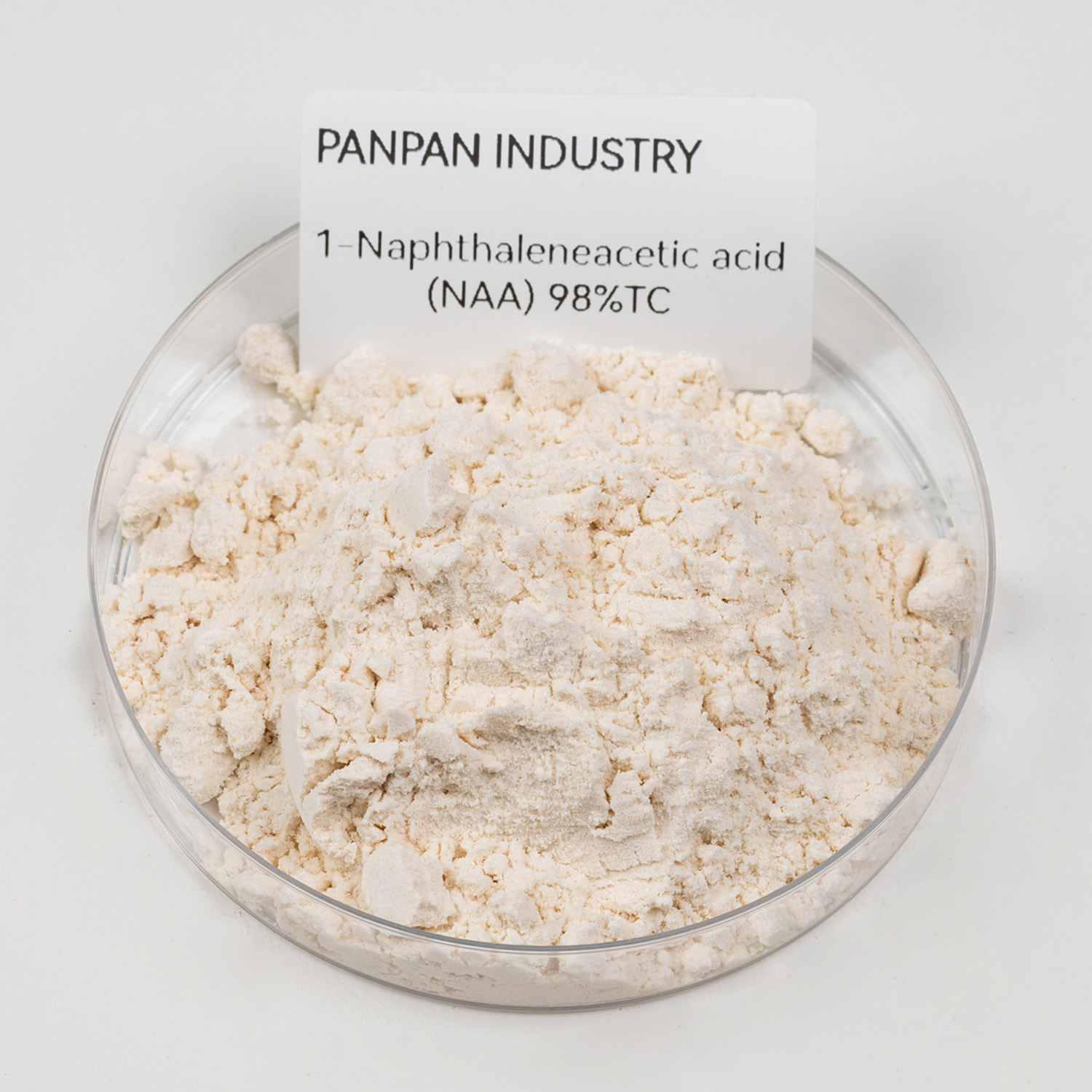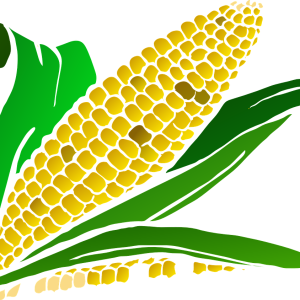1-Naphthylacetic Acid NAA
Naphthaleneacetic acid (sodium) can increase the flowering and fruiting rate, prevent flowers and fruits from falling, and has an anti-drop function. It can not only increase yield, improve quality, promote luxuriant branches and leaves, and make plants strong, but also effectively improve the crop’s ability to resist drought, cold, waterlogging, disease, salt and alkali, and stress.
[1]Chinese general name: 1-naphthyl acetic acid, α- Naphthylacetic acid, α- Naphthalene acetic acid
[2]English general name: NAA, 1-sodium acid acid
[3]Trade name: Naiqi, caiacetic acid
[4]Chemical name: a-naphthyl acetic acid
[5]CAS No. 86-87-3
[6]Molecular formula:C12H10O2
[7]Relative molecular weight:186.2
[8] Physical and chemical properties
Pure naphthylacetic acid is white odorless crystals, and industrial products are off-white powders; melting point 130℃, boiling point 285℃; insoluble in water, solubility in water at 20℃ 240mg/L, soluble in hot water, easily soluble in organic solvents such as acetone, ether, benzene, ethanol, chloroform, etc.; easy to change color when exposed to light, can form salts when exposed to alkali, salts can be dissolved in water, and are stable when stored at room temperature.
[9] Toxicity Low toxicity
[10] The main dosage forms 85% naphthyl acetic acid technical, 98% naphthyl acetic acid sodium salt, 1% naphthyl acetic acid aqueous solution, 20% naphthyl acetic acid soluble powder, 40% naphthyl acetic acid (sodium) soluble powder
[11]Functional characteristics
Naphthaleneacetic acid (sodium) is an auxin plant growth regulator. In addition to the basic functions of general auxins, it can also promote the formation of adventitious roots and roots of plants. It is used to promote seed rooting, cutting roots, and fibrous root growth of Solanaceae crops. It can promote the rapid expansion of fruits, tubers, and rhizomes, so it can be used as a growth hormone on vegetables and fruit trees. It can increase the flowering and fruiting rate, prevent the falling of flowers and fruits, and has the function of preventing falling of fruits and flowers. It can not only increase the yield, improve the quality, promote the luxuriant branches and leaves, and make the plants strong, but also effectively improve drought resistance, cold resistance, waterlogging resistance, disease resistance, salt and alkali resistance,e and stress resistance of crops.
[12] Application technology
Promote the formation of adventitious roots and roots
Ginkgo: biloba cuttings dipped in 600mg/L naphthaleneacetic acid solution for 10s can promote rooting and improve the survival rate.
Dijin: cuttings dipped in 1000~2000 mg/L naphthaleneacetic acid solution for 10s can improve the rooting rate and number of roots and promote survival.
Fructus fruticosa immersion of hard and tender branches of Fructus fruticosa in 500mg/L naphthaleneacetic acid for 2h can greatly improve the rooting rate.
Berberis purpurogena: Dipping the young branches with 500mg/L naphthaleneacetic acid solution for 10 seconds can increase the rooting rate to 94.2%.
Azalea: Treating the branches of azalea with 80~100mg/L naphthaleneacetic acid solution can promote the rooting of azalea hydroponic cuttings.
Osmanthus: During the process of cutting young branches of osmanthus in full light mist, soak the cuttings with 200mg/kg naphthaleneacetic acid for 60min, and cooperate with water supply: turn on the spray device after cutting, spray for 30 each time, with an interval of 2min, callus tissue begins to appear on the cuttings in the second week, and then spray for 30s each time, with an interval of 30min. In the 3rd to 4th week after cutting, the cuttings begin to take root. Spray for 30 seconds each time, with an interval of 2h, which can greatly improve the rooting rate.
Red endwood: Soaking the cuttings with 100 mg/L naphthaleneacetic acid solution for 2h can promote the rooting rate of cuttings and increase the number of roots.
Bauhinia safflower Use 150 mg/L sodium nitrophenolate + 600 mg/L naphthaleneacetic acid to quickly dip the cuttings of Bauhinia safflower for 5~10s, which can significantly improve the rooting effect of the cuttings of Bauhinia safflower.
Bamboo willow Soak the tender branches of bamboo willow in 120mg/L naphthaleneacetic acid solution for 45 minutes, and the germination rate and rooting rate of bamboo willow tender branches are improved.
Grape Before cutting, dip the branches in 100~200mg/L solution for 6~12h, which can promote the rooting of the branches, germination is fast, and the plant development is strong.
Tree transplanting Use 50~100mg/L solution, soak the base for 24h; or 1000~2000mg/L solution, soak the base for 3s, which can promote rooting and improve the survival rate.
Tea, mulberry, metasequoia, etc. Soak the base of the cuttings with 10~15mg/L solution for 24 hours or soak the base of the cuttings with 60~100mg/L solution for 3~4 hours to promote rooting.
Mongolian oak Soaking seeds with 150mg/L naphthaleneacetic acid for 12 hours has a significant effect on the growth of Mongolian oak seedlings, and the seedling height, ground diameter, main root length and number of lateral roots are significantly increased.
Fujian Phoebe Soaking the cuttings with 100~600mg/L naphthaleneacetic acid solution for 6 hours can improve the rooting rate.
Pecan Soaking the base of the cuttings with 500mg/L naphthaleneacetic acid solution for 6 hours can significantly improve the rooting rate and number of roots.
Sweet potato Bundle the potato vines, soak the base with 10~20mg/L solution 3~4cm deep, and transplant the seedlings after 6 hours; or dip the seedlings with 80~100mg/L solution for 3s and transplant them immediately. It can improve the survival rate, expand the potato tubers, and increase the yield.
Cucumber: Soak seeds in 10mg/L solution for 12h, remove and rinse with clean water 1~2 times, and sow after drying, which can promote rooting and germination, and make the seedlings strong and even.
Radish and cabbage: Soak seeds in 15~30mg/L solution for 12h, remove and rinse with clean water 1~2 times, and sow after drying, which can promote rooting and germination, and make the seedlings strong and even.
Promote the development of grains and fruits and increase yield
Wheat: Soak seeds in 10~20mg/L solution for 12h, remove and rinse with clean water 1~2 times, and sow after drying; spray flag leaves and ears with 15~30mg/L solution 20~30d after transplanting, which can promote tillering, increase ear formation rate, increase the number of grains per ear and thousand-grain weight, and promote yield increase. At the same time, it can also improve the plant’s resistance to salt and alkali and dry hot winds.
Rice: Soak seeds in 10~20mg/L solution for 6 hours before transplanting; Spray flag leaves and ears with 10~20mg/L solution to promote greening, make plants strong and increase yield. It can also be used in the nursery field, spraying 5~10mg/L solution on the leaves can promote the development of the seedling root system.
Corn and millet: Soak seeds in 20~30mg/L solution for 12 hours, remove and rinse with clean water 1~2 times, and sow after drying; spray 15~20mg/L solution on the leaves during the growth period to promote growth and increase yield.
Cotton: Spray the leaves with 5~7.5mg/L solution once during the flowering period to prevent buds and bolls from falling off, enlarge the fruit, improve quality and increase yield.
Tomatoes and eggplants: Spray the leaves with 5~10mg/L solution before the plant is established and at the beginning of the flowering period, spray once every 10~15d, for a total of 3 times, to promote growth and increase yield.
Cucumber Spray the whole plant 1-2 times with 5-10 mg/L solution during the growth period to increase the density of female flowers and regulate growth.
Pepper Spray the flowers with 20-50 mg/L solution during the flowering period to prevent flower drop and promote pepper production. The yield is 13.4% higher than the control.
Beans Soak seeds in 10-20 mg/L solution for 0.5-1h before sowing; spray 5 mg/L solution 2-3 times during the growth period to promote growth, accelerate maturity and increase yield.
Potato Soak the tubers in 10-20 mg/L solution for 12-24h to promote germination.
Pineapple Spray leaf buds and flower buds with 10 mg/L solution before flowering; spray young fruits with 20 mg/L solution 2-3 times when forming fruits; inject 30 mL of 15-20 mg/L solution from the center of the plant in the late vegetative growth period to promote growth and increase yield.
Sugarcane: Spray the leaves with 15~20mg/L solution 2~3 times during the tillering period to promote growth and increase yield.
Lemon: Spray the lemon crown with 100~200mg/L solution before the fruit matures to accelerate fruit ripening and increase yield.
Tobacco: Spray the leaves with 10~20mg/L solution 2~3 times during the growth period to regulate plant growth and improve tobacco leaf quality.
Bletilla: Treat Bletilla seeds with 0.5~1mg/L solution, which promotes the growth of seedlings, seedling leaf length, leaf width, and plant height.
Citrus: Spray the fruit pedicle with 40~60mg/L solution 15d before harvest to prevent fruit drop before harvest and increase yield.
Apple, pear, and red dates: Spray the whole plant with 15~20mg/L solution starting 45d before harvest, and spray once every 15 to promote growth, prevent fruit drop before harvest, and increase yield.
Watermelon When the female flowers first bloom, soak or spray the flowers with 20~30mg/L solution to increase the fruit setting rate.
Pumpkin When flowering, apply 5~20mg/L solution to the ovary to increase the fruit setting rate.
Thinning flowers and fruits
Apple “Golden Crown” apples were sprayed with 20mg/L naphthaleneacetic acid 14 days after full bloom, and the fruit setting rate of 100 inflorescences decreased by 40.5% compared with the control. Under normal circumstances, the use of naphthaleneacetic acid to thin apple trees should be controlled within 10 days after full bloom for early-maturing varieties, and the effective thinning period for mid-maturing and late-maturing varieties is 10~15 days. The spraying concentration depends on the apple variety. Usually, 5~10mg/L naphthaleneacetic acid is sprayed on apples such as “Zaoxu”, “Hongyu”, “Xu”, “Chilong” and “Wajin”, while 10~20mg/L is suitable for “Jinguan”. For “Huayome” with a strong habit of bearing fruits every other year, the spraying concentration should be controlled at 15~20mg/L.
Note that naphthaleneacetic acid should not be used as a fruit thinning agent for “Marshal” and “Red Star” apples, to avoid inhibiting the growth of young fruits and forming small fruits, which will lose their edible value; early-maturing varieties are best sprayed during the petal drop period. If sprayed 10 days after full bloom, it is easy to cause the fruit to fail to reach the required maturity, resulting in early maturity and cracking; fruit thinning agents should not be used for some apple orchards with frost damage, poor soil drainage, nitrogen deficiency and high density of planting causing insufficient light.
Peach Spraying 40~60 mg/L naphthaleneacetic acid solution 20~45 days after flowering can effectively remove excess fruits and control the amount of fruit hanging.
Pear and mandarin orange: Spray 100~300mg/L solution once during the flowering period to effectively remove excess fruits and control the amount of fruit hanging.
Persimmon: Spray 5~10mg/L naphthaleneacetic acid solution 10 days after flowering to remove excess fruits and control the amount of fruit hanging.
Apricot and plum: Spray 20~30mg/L naphthaleneacetic acid once 1~2 days during the flowering period to effectively thin flowers and improve the quality of apricot and plum fruits.
[13] Precautions
① Naphthaleneacetic acid is difficult to dissolve in cold water. When preparing, it can be dissolved in a small amount of alcohol and then diluted with water, or first add a small amount of water to make a paste and then add an appropriate amount of water, and then add sodium bicarbonate (baking soda) and stir until it is completely dissolved.
② Using naphthaleneacetic acid to thin flowers and fruits of early-maturing apple varieties is prone to phytotoxicity. Using 40 mg/L naphthaleneacetic acid for autumn white pear will cause a reduction in yield, and too high a concentration will cause deformity, withered leaves, and falling off; using 50 mg/L naphthaleneacetic acid or more for figs will cause phytotoxicity; using too high a dosage for watermelons and melons is prone to phytotoxicity.
③Naphthaleneacetic acid can cause poisoning through the esophagus, and liver and kidney damage can be seen. There is no specific antidote. If symptoms of poisoning occur, go to the hospital immediately for treatment.
Please consult for details
Our other website specializes in regulators, insecticides, fungicides, and herbicides:plantgrowthhormones.com
We are based in Henan, China, start from 2021,sell to South America(31.00%),North America(25.00%),Western Europe(15.00%),Central America(8.00%),Oceania(5.00%),Eastern Asia(5.00%),Eastern Europe(4.00%),Southeast Asia(3.00%),South Asia(2.00%),Africa(00.00%),Mid East(00.00%). There are total about 5-10 people in our office.
Always a pre-production sample before mass production;
Always final Inspection before shipment;
Gibberellin GA3,Cytokinin,Rooting Hormone,Fruit Coloring,Plant Growth Inhibitor
1. Professional supplier of Gibberellic acid,IBA, 6-Benzylaminopurine, CPPU,abscisic acid and other plant growth regulators 2. 12 years exporting experience with customers all over the world 3. Product has been approved by SGS
Accepted Delivery Terms: FOB,CFR,CIF,EXW,FAS,CIP,FCA,CPT,DEQ,DDP,DDU,Express Delivery,DAF,DES;
Accepted Payment Currency:USD,EUR,JPY,CAD,AUD,HKD,GBP,CNY,CHF;
Accepted Payment Type: L/C,D/P D/A,MoneyGram,Credit Card,PayPal,Western Union,Cash,Escrow;
Language Spoken:English,Chinese,Spanish


